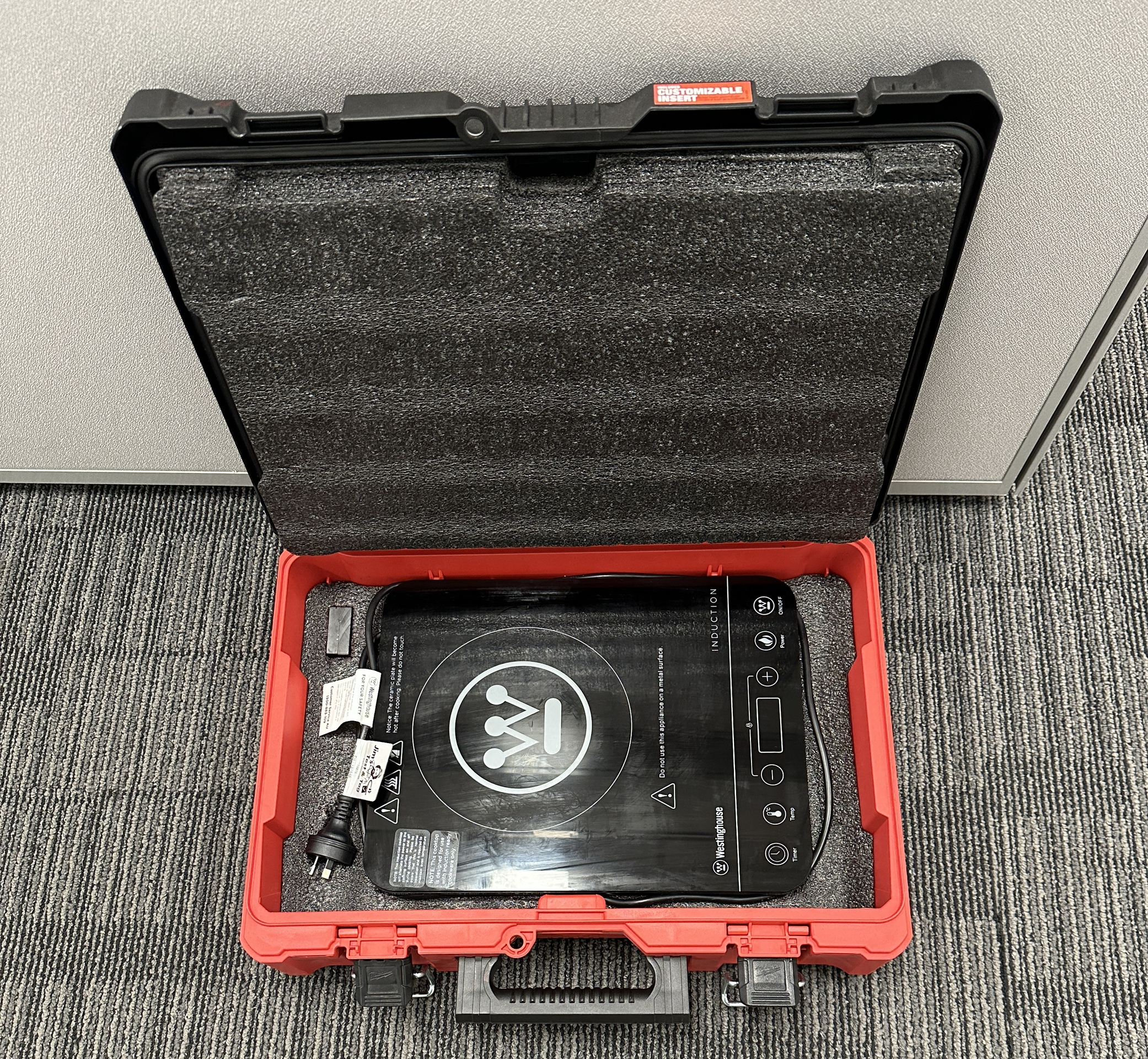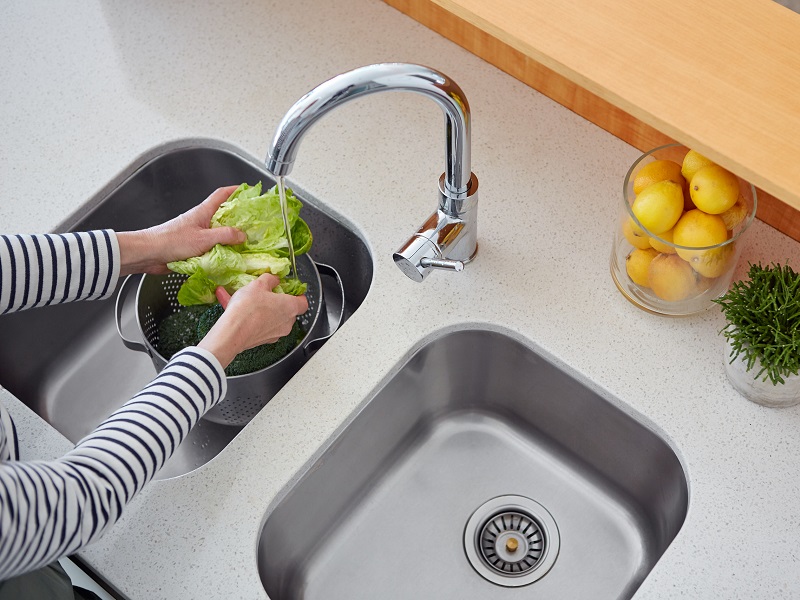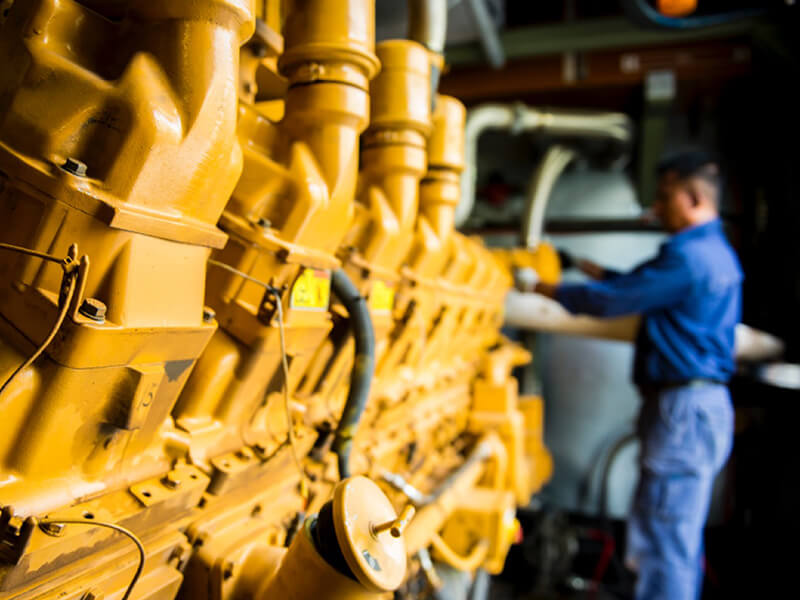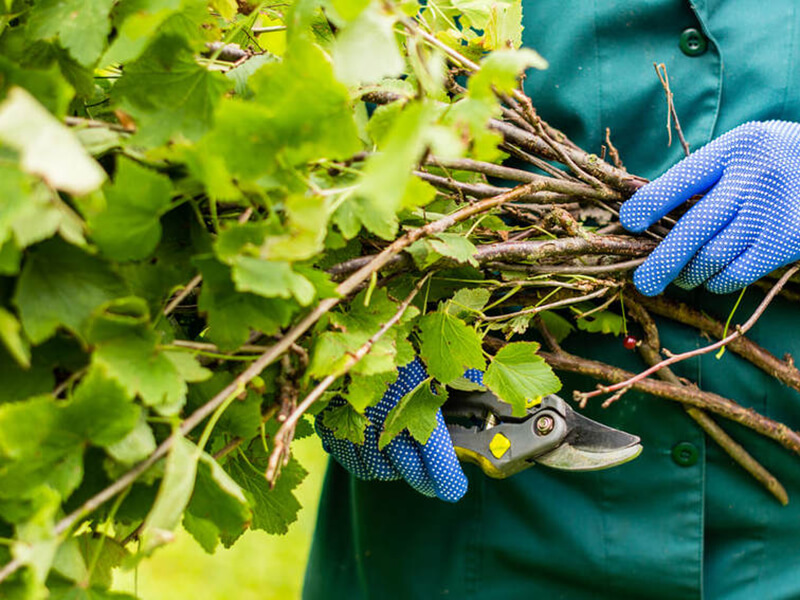What is living sustainably?
Living sustainably helps the environment and makes sure future generations will have the natural resources they need. It can also be good for your health and save you money!
Cut power use, save money
The cheapest energy you can get is the energy you don’t use!
Building an energy efficient home and using energy efficient appliances cuts your energy use but gives you the same liveability – and that saves money.
In fact, by taking the right steps, your power bills can be slashed by more than 50%!
Increasing your home’s energy efficiency may cost more up front but the investment is returned through reduced power costs.
For the best results, plan your energy-efficient home before you buy your block and during the design phase, focusing on energy efficient heating/cooling and water heating to save the most money.
You can also save power and money by using energy-efficient appliances.
How can I reduce my living costs?
There are many small and large changes you can make to reduce your bills
-
Appliances keyboard_arrow_right
It is estimated that 10% of an average home’s electricity bill is standby power, that is the appliance is using power even though the device isn’t in use (for example televisions, DVD players, set top boxes, game consoles, stereos, computers, mobile phone charges). A typical household in Albury could save $340 per year by turning appliances off at the wall when not in use. Find out how much your appliances are costing by borrowing the libraries Save Power Kit.
When purchasing a new appliance check out its Energy Rating. Assuming you use the appliance per its description below the stars, simply divide the energy consumption figure by 4 and it will give you the rough cost to run the appliance per year. This works as energy rates range from 20 cents to over 30 cents so using 25 cents gives a rough estimate.
-
Choosing the right block keyboard_arrow_right
When selecting your block, consider:
- Rectangular blocks that enable living areas to face north;
- Are the sun’s rays to the block impacted by the lot size, orientation, slope of the site and vegetation or adjoining buildings? Solar access to the block is important for passive heating/cooling, solar hot water and / or a solar PV;
- Check how the terrain or vegetation could affect air movement and solar access;
- Potential overshadowing from height and spread of trees, and neighbouring houses;
- The benefits from existing vegetation relating to wind protection and summer shading.
-
Cool roofs keyboard_arrow_right
Lighter colour roofs typically have a low solar absorptance compared to darker coloured roofs. Solar absorptance is a measure of how much solar radiation the roof absorbs (0 indicates no roof absorbance and 1 indicates the roof absorbs 100%). Houses with a low solar absorptance roof heat up less in summer months and thus require less air conditioning.
Examples of the solar absorptance of roofing products include:
-
Design considerations keyboard_arrow_right
The smaller a home’s footprint, the easier it is to achieve high energy efficiency.
Building or renovating your home is a chance to make your life significantly more sustainable right from the outset – aspect, insulation, windows and building materials can all have a substantial impact on your home’s environmental footprint. Designing these features well will set you up for a life with lower energy bills and more comfortable living spaces. And, as always, the smaller a home’s footprint, the easier it is to achieve high energy efficiency.
The following is taken from Your Home and should be provided to your draftsperson or architect early in the design phase to discuss options for your new home.
- Use high levels of well-insulated thermal mass.
- Use north-facing, high thermal mass living areas with passive solar access.
- Select a site exposed to cooling breezes, and design to exclude adverse winds while allowing for cross-ventilation and night purging.
- Design to capture cool air drainage on still nights (cool air flows in similar patterns to water as surface temperatures drop due to night sky radiation).
- Limit external wall area.
- Choose compact floor plans with central, closable stack ventilation shafts or solar chimneys.
- Consider central courtyards with evaporative cooling water features to allow night cooling with wind protection.
- Use mechanical ventilation in ceiling spaces to ensure high level flows of cooler (south-side) air in summer and a complete seal in winter.
- Provide screened, shaded outdoor living areas that allow winter sun penetration.
- Use garden ponds and water features outside windows to provide evaporative cooling.
Windows and shading
- Avoid overuse of glazing.
- Use different glazing types for each façade; low U-value glazing is essential in all cases.
- Double glaze living areas and consider using it in bedrooms.
- For north-facing windows select high SHGC glazing and passive shading.
- For east and west façades select low SHGC coatings (e.g. low-e).
- South-facing glass should have low U-value and high visible light transmittance.
- Thermally improved or insulated frames (timber or PVC) are important.
- Passive solar shading to northerly windows is critical.
- Shade all east and west glass in summer.
- Consider adjustable shading to allow variable solar access in spring and autumn.
Insulation
- Refer to Insulation for appropriate insulation levels in each climate zone and recommended minimum insulation levels.
- Use bulk and reflective insulation in ceilings, and bulk or reflective insulation in walls.
- Provide external insulation to all thermal mass.
- Insulate under concrete slabs if using in-slab heating.
- Insulate elevated floors (concrete or lightweight).
- Ensure all spaces are effectively air sealed.
Heating and cooling
- Use evaporative cooling and passive solar heating in living areas.
- Provide ceiling fans in all living and sleeping spaces.
- Consider active solar heating and reverse night cooling connected to in-slab hydronic systems in more extreme regions.
- Check typical heating and cooling requirements in the local area to determine appropriate passive heating levels (consult your local thermal performance expert).
Construction systems
- Prefer high thermal mass construction.
- Use earth coupled slabs.
- Choose light coloured roof materials
-
Eaves keyboard_arrow_right
Eaves provide the least expensive method for shading on northern elevations. A common error with eaves places the top of the window in permanent shade but this can be easily corrected in the design stage.
-
Heating and cooling keyboard_arrow_right
If considering supplementary heating and/or cooling for your home, select a system that suits your needs and is energy efficient. To maximise your home’s comfort and energy savings ensure that draughts around doors and windows are sealed, roof and walls are insulated and hang heavy curtains with pelmets.
Keep room temperature between 18-21oC in winter and 23- 26oC in summer. Each degree change from these recommendations can increase the heating/cooling of your home up to 15%.
For more information about heating and cooling options visit energy.gov.au.
-
Hot water services (HWS) keyboard_arrow_right
Check out the different options and consider your household size, up front purchasing cost and operating costs, space available and energy sources available to you.
A HWS with storage can waste 30% of the energy it uses due to heat loss from the tank and hot water pipework. To minimise the loss of hot water, locate wet areas near the kitchen where frequent small amounts of hot water are used.
When determining the best hot water service for your home consider:
- Household size, space available, upfront and operating costs, solar access and energy sources available;
- Ensure roof pitch and orientation is suitable for a future solar water heater. Solar boosted solar electric or gas booster solar water heaters generate fewer greenhouse gas emissions; and
- Solar and heat pumps may be more suited where natural gas is not available, as LPG can be expensive if a lot of hot water is used. A heat pump can provide a 45% reduction in running costs. For more information read the Heat Pump Water Heater guide for Households;
- If your system has a storage tank, ensure it is sized appropriately. Too small and you’ll run out of water, too big and you’ll have excessive running costs;
- Install water efficient showerheads as showering uses the most hot water in an average household (and if you buy a continuous flow HWS make sure the water efficient showerhead is compatible).
Also be aware if installing mixer taps these can waste hot water if not used correctly. Be sure to leave the handle in the cold position.
-
Induction Cooking keyboard_arrow_right
Induction cooking is a healthy, low cost and safe cooking option.
Evidence is growing on the benefits of removing gas from our homes. Healthy Futures and NSW Doctors for the Environment are advocating to create healthier homes by transitioning homes to all electric. The Healthy Futures website states:
‘A child living with gas cooking in their home faces a similar risk of asthma to a child living with household cigarette smoke. Indoor gas has been estimated to be responsible for up to 12% of childhood asthma in Australia’.
Asthma Australia also recommends that internal gas appliances are switched to electric to reduce harm.
Fortunately, the solution to a healthier home is also the most cost efficient; this is especially important during the current cost of living crisis!
Try before you buy!
Library members can borrow a Westinghouse Portable Induction Cooktop for free for up to two weeks.
The portable induction cooktops provide our community with an opportunity to experience the benefits of cooking with an induction cooktop prior to making the upfront purchase.
The Induction cooktops are loaned in a large protective carry case. These do not fit in the book return shoot and thus will need to be retuned during library opening hours to the front desk. A Library Officer will inspect the unit to ensure it is returned in a satisfactory condition.
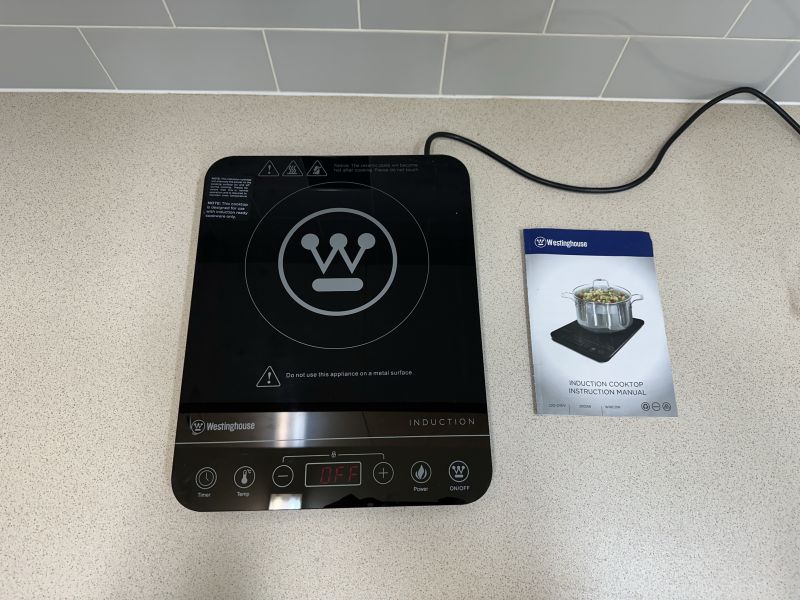
How to make the switch
Here is a step-by-step guide about switching to an induction cooktop:
Size and Power Requirements: When selecting the size of a new induction cooktop consider your existing cooktop hole, kitchen space and cooking needs.
Induction cooktops have a larger kW draw compared to traditional electric cooktops; electrical cabling may need replacing when making the switch.
Budget: Induction cooktops can vary significantly in price, depending on the features and brand. Set your budget accordingly.
Brand and Warranty: When buying an induction cooktop, consider buying from a reputable supplier and review previous customer feedback. Also, check if the cooktop includes a warranty for added peace of mind.
Installation Requirements: An induction cooktop must be installed by a licensed electrician in compliance with Australian standards. You can verify that your electrician has a current and valid license with NSW Fair Trading.
Power Requirements: Most homes can run an induction cooktop on single-phase power, but it is worth checking with an electrician first. They may need to add a circuit, as cooktops often require 20A, 32A, or 42A cables[1]. While three-phase power is rarely needed, it’s best to confirm before buying. Induction cooktops usually operate on 120V or 240V and use between 1,000 and 4,000 watts depending on size and burners.
NOTE: When switching from a gas stove to an induction cooktop, the gas line will no longer be needed. It’s crucial that a licensed plumber or gas fitter properly manages the disconnection and securely seal off the gas line to ensure safety.
Testing: Once the installation is complete, the electrician will test the cooktop to ensure it operates safely and effectively.
Compatible Cookware: Induction cooktops require flat bottomed, magnetic cookware to work. If a magnet sticks to your existing cookware they should work with your new induction cooktop.
If you require more information about shifting from gas stove cooktop to induction cooktop, check out this article from CHOICE.
Upgrading to an induction cooktop will lower your household’s exposure to unhealthy fumes that can trigger asthma, however if transitioning away from gas for economic reasons, an induction cooktop should be completed after replacing your gas hot water and space heater as these are larger consumers of gas. For more information on how to save money visit Sustainable Households.
FAQs
- How to make the decision between an electric and an induction cooktop?
A comprehensive comparison between electric and induction cooktops is shown in the following table.
Electric
Induction
Heat Source
Electric coils beneath a smooth glass surface.
Uses electromagnetic fields to directly heat pots.
Heat Control
Slower to adjust.
Precise and instant heat control.
Efficiency
Moderate efficiency (heat loss to surface).
Ceramic cooktops don't conduct heat as efficiently as induction.
Highly efficient due to direct heating; this can reduce cooking time.
Cookware Compatibility
Works with any cookware.
Requires cookware with a magnetic base (steel, cast iron, etc).
Heat Distribution
More even than traditional electric coils.
Even heat distribution as the cookware itself heats.
Temperature Control
Moderate temperature control. Ceramic cooktops are slower to adjust to changing the temperature.
Offers precise, digital temperature settings.
Health Impact and Safety
The surface can remain hot.
Safe, may pose a risk if not used with proper cookware. Not recommended for people with a pacemaker.2
If using a portable cooktop, plug directly into a wall socket, do not use an extension cord.
Cost
Moderate initial cost; low running cost.
Higher upfront purchase cost of cooktop but lower operational costs due to efficient heating method and lower cost of energy per unit.
Durability
Glass can scratch or crack.
Generally durable, but sensitive to cracks or breaks in the cooktop.
Startup Time
Takes 30 seconds or a minute to reach the desired temperature.
Instant heat, with very fast response times.
- How does an induction cooktop work?
Induction cooktops generate heat by creating an electromagnetic field between the cooktop and compatible cookware.
- What cookware can I use with an induction cooktop?
Only magnetic cookware works with induction cooktops. Cookware made from cast iron, magnetic stainless steel, or specific induction-compatible materials is required.
Non-magnetic cookware (like aluminium or copper) will not work.
- How do I know if the cooktop is compatible with my cookware?
To test if your cookware is induction-compatible, you can try sticking a magnet to the bottom of the pot or pan. If the magnet sticks, it will work with an induction cooktop.
- Is it safe to use an induction cooktop?
- Why try a portable induction cooktop?
It is a convenient, energy-efficient option for cooking when you do not have access to a traditional stove; want to try induction before installing a full-size cooktop; or want to use an induction cooktop while renting.
- What is a portable induction cooktop?
A portable induction cooktop is a compact, electric cooking device that uses magnetic induction to heat cookware directly.
- What if the portable induction cooktop stops working?
Turn the unit off at the power point and unplug the cooktop. When the unit is cool, place it in the carry case and return to an Albury library. Be sure to inform the librarian about the issue when you return it.
- What if the portable induction cooktop gets damaged while I have it on loan?
Return the induction cooktop to an Albury library and inform the librarian about the issue. You may be subject to a cleaning or replacement fee.
- What if I need a portable induction cooktop for a longer period?
The cooktop is borrowed just like a book. If no one else has reserved the item, your loan will automatically be extended by two weeks.
- When should I not use the portable induction cooktop?
Yes, induction cooktops are safe. They do not work with flames and only heat up the pots on the hot surface which reduces the risk of burns. Many models also include safety features like automatic shut-off, child locks, and temperature sensors.
Read the instruction manual carefully before using the induction cooktop. Do not use the portable induction cooktop if:
- the cord or plug is hot, split, melted or damaged.
- the cooktop has malfunctioned.
- the cooktop has been damaged in any manner.
Reserve a Portable Induction Cooktop
Westinghouse Induction Cooktop Instruction Manual
Safety Instruction for Borrowers
For more information visit:
A practical guide to electrification for new buildings
Gas appliances - Asthma Australia
- How to make the decision between an electric and an induction cooktop?
-
Lighting keyboard_arrow_right
Household lighting costs are decreasing as light emitting diodes (LEDs) are replacing halogen and incandescent lights. LEDs save money as they use up to 75% less energy and need replacing less often.
When designing your home consider:
- How to minimise artificial lights during daylight hours;
- Avoid rooms with a dark interior as this will absorb light and require more artificial light to be provided;
- General lighting and task lighting for each space;
- Locating switch so they are easily turned off when leaving the room;
- A lower wattage light as this will save energy costs compared to dimming;
- Energy efficient LEDs over lighting types that are be phased out; and
- Sky lights as these can provide three times as much light into a room compared to a vertical window.
-
Passive solar home design keyboard_arrow_right
Take advantage of the climate to maintain a comfortable temperature range in your home without (or greatly reduced) supplementary heating or cooling and save up to 40% of energy use in Australian homes or nearly $1,370 per annum in Albury.
For more information visit Your Home
-
Roof pitch and orientation keyboard_arrow_right
If you’re not installing solar or solar hot water during construction, ensure pitch and orientation allows for installation in the future.
Panels perform best when they are installed at an angle as they capture more energy from the sun. The added benefit is the angle also assists rain to wash off dust and grime.
A flat roof will require solar panels to be mounted to at least 10 degrees to avoid rain damage to the panels. However, the additional cost of adding a frame to a flat roof to tilt the solar panels is generally not cost effective.
Solar panels used to be installed facing north to maximise daily production. However, if you want to save the most on your electricity bill, you may be better to have some panels facing partially east and some partially west so that the panels are generating electricity from sunrise to sunset.
-
Solar Photovoltaic Panels (PV) keyboard_arrow_right
Electricity prices have increased significantly over the past few years and one method to reduce your bills further is to install solar. Solar should be considered after implementing energy efficient options identified above as this will reduce the size of the solar system required and thus its cost and how long it takes to pay it off. Generally, a warranty on a PV system is for 20+ years and a system can be paid back in under 5.
For more information read the Clean Energy Council’s Guide to installing solar for households
-
Weather sealing keyboard_arrow_right
Draughts can increase heating and cooling costs by 25%, or $340 per year for an average 4-5 person Albury home. These costs can be reduced by installing draught seals around doors and windows. Internal doors can also have draught seals to minimise heat loss between rooms that are air conditioned or heated with those rooms not in use. This is a cost effective way to save energy and can easily be completed on existing homes.
The other benefit is that it stops windows from rattling!
-
Windows keyboard_arrow_right
Position windows and or doors on more than one side of a room or house to enable natural cooling by cross ventilation.
Use internal lined curtains or close-fitting Holland and or roman blinds with pelmets. Vertical blinds, conventional or timber venetians are generally not as good at keeping the heat out during summer or warmth in during winter.
